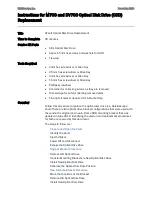
W632GU6NB
Publication Release Date: Aug. 20, 2018
Revision: A01
- 157 -
10.16.5 Data Setup, Hold and Slew Rate Derating
For all input signals the total t
DS
(setup time) and t
DH
(hold time) required is calculated by adding the
data sheet t
DS(base)
and t
DH(base)
value (see Table 53) to t
he Δt
DS
and Δt
DH
(see Table 54 and Table
55) derating value respectively. Example: t
DS
(total setup time) = t
DS(base)
+ Δt
DS
.
Setup (t
DS
) nominal slew rate for a rising signal is defined as the slew rate between the last crossing
of V
REF(DC)
and the first crossing of V
IH(AC)
min. Setup (t
DS
) nominal slew rate for a falling signal is
defined as the slew rate between the last crossing of V
REF(DC)
and the first crossing of V
IL(AC)
max
(see Figure 107). If the actual signal is always earlier than the nominal slew rate line between shaded
‘V
REF(DC)
to AC region’, use nominal slew rate for derating value. If the actual signal is later than the
nominal slew rate line anywhere
between shaded ‘V
REF(DC)
to AC region’, the slew rate of a tangent
line to the actual signal from the AC level to V
REF(DC)
level is used for derating value (see Figure 109).
Hold (t
DH
) nominal slew rate for a rising signal is defined as the slew rate between the last crossing of
V
IL(DC)
max and the first crossing of V
REF(DC)
. Hold (t
DH
) nominal slew rate for a falling signal is
defined as the slew rate between the last crossing of V
IH(DC)
min and the first crossing of V
REF(DC)
(see Figure 108). If the actual signal is always later than the nominal slew rate line between shaded
‘DC level to V
REF(DC)
region’, use nominal slew rate for derating value. If the actual signal is earlier
than the nominal slew rate
line anywhere between shaded ‘DC to V
REF(DC)
region’, the slew rate of a
tangent line to the actual signal from the DC level to V
REF(DC)
level is used for derating value (see
Figure 110).
For a valid transition the input signal has to remain above/below V
IH/IL(AC)
for some time t
VAC
(see
Table 56).
Although for slow slew rates the total setup time might be negative (i.e. a valid input signal will not
have reached V
IH/IL(AC)
at the time of the rising clock transition) a valid input signal is still required to
complete the transition and reach V
IH/IL(AC)
.
For slew rates in between the values listed in the tables the derating values may obtained by linear
interpolation.
These values are typically not subject to production test. They are verified by design and
characterization.
Table 53
– Data Setup and Hold Base-Values
Symbol
Reference DDR3L-1333 DDR3L-1600 DDR3L-1866 DDR3L-2133
Unit
Notes
t
DS(base) AC135
V
IH/L(AC)
:
SR=1 V/nS
45
25
-
pS
1
t
DS(base) AC130
V
IH/L(AC)
:
SR=2 V/nS
70
55
pS
2
t
DH(base)
DC90
V
IH/L(DC)
:
SR=1 V/nS
75
55
-
pS
1
t
DH(base)
DC90
V
IH/L(DC)
:
SR=2 V/nS
75
60
pS
2
Notes:
1. (AC/DC referenced for 1V/nS DQ-slew rate and 2 V/nS DQS slew rate)
2. (AC/DC referenced for 2V/nS DQ-slew rate and 4 V/nS DQS slew rate).






































